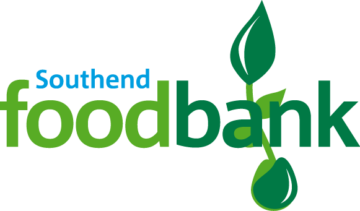2019 marked six years of Southend Foodbank supporting the local community, it was also our busiest year and the year we saw the sharpest rise in the number of people needing help. Fortunately, we also received more donations than ever before and had support from more organisations and groups.
- More than 2400 referrals were made to Southend Foodbank in 2019
- Food was distributed for around 3500 adults and 2800 children
- On average the foodbank distributed food for more than 500 people each month in 2019. We distributed food for more than 600 people in a month for the first time in October and for more than 700 people in December.
In some ways 2019 was similar to the previous two years: the busiest period was in the last three months of the year (Q4) and every part of the year was busier than the same period in the previous year. However, the rate of change or how much busier we have been, has increased – you can see that on the graph where the 2019 line is much higher up the scale and there is a bigger gap between the 2019 and 2018 lines than the gap between earlier years. Although the coldest months (January-March and October-December) were the busiest in 2019, even the ‘quieter’ months in 2019 were busier than previous years.
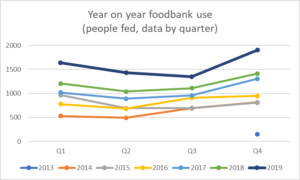
The foodbank welcomed 23% more people in 2019 than the year before and the total number of people fed increased by 33%. Those two numbers are different because the increase in families being referred to the foodbank was bigger than the increase in the number of single or couple households being referred. This indicates that need is increasing across the community but is especially increasing in families with children. In 2019, food from Southend Foodbank was distributed to 23% more adults and 46% more children compared to 2018.
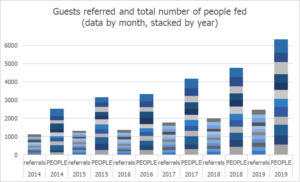
When people are referred to the foodbank, a main reason for the referral is noted. Low income (38%), benefit delays (20%) and benefit changes (16%) were the most common problems in 2019, as well as debt, domestic violence, homelessness and sickness.
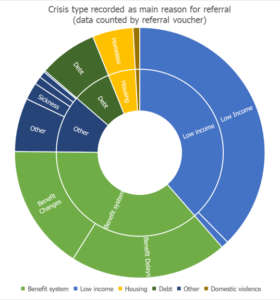
In 2019, people struggling to put food on their table came to the foodbank from across a wide geographic area, visiting distribution centres in Hawkwell, Leigh, Westcliff, Southend and Shoebury. Areas with higher local deprivation, indicated on the map as darker shades of blue, generally have more households being referred to the foodbank.
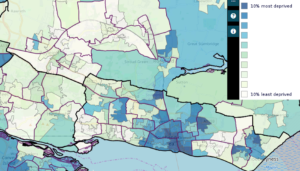
Food was distributed for more than 1500 people in Kursaal; > 600 in Victoria and Milton; >300 in Shoeburyness, Southchurch and Chalkwell; >200 in West Shoebury, St. Luke’s and Westborough; >100 in St Laurence, Prittlewell and Blenheim Park; >60 in Roche North, Roche South, Hawkwell East, Foulness and the Wakerings; > 30 in Leigh, Eastwood Park, Thorpe and Belfairs; and >20 in West Leigh and Wheatley. However, households from every part of Rochford, Southend East, Southend West, Rayleigh and Hockley were helped by Southend Foodbank last year.
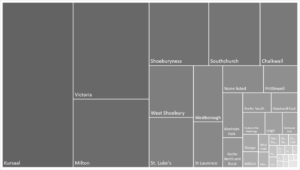
Donations also came from across the community and there are now more permanent collection points in supermarkets, organisations and churches supporting Southend Foodbank than ever before. Despite overwhelming generosity from the community, there were times in 2019 when we ran out of some food items. Around 1.2 tonnes of food was purchased by the foodbank in 2019, especially in the middle part of the year when donations decreased. Purchasing food was necessary to make sure that the food parcels we distributed had sufficient food for three days, and also met basic nutritional guidance. However, this puts a strain on the charity, needing to find money to pay for food purchases as well as running costs.
At the start of 2020 there is no clear evidence that the need for help from the foodbank is decreasing in Southend and surrounding areas, and we expect significant challenges in the year ahead.
A note on the figures presented here: Where do the foodbank numbers come from?
Guests and referrals
Guests are counted as the number of people who receive a referral voucher and use it at any of the seven distribution centres. The referrals figure might be lower than the total number of referrals made by outside agencies if people are given a voucher but don’t use it, for reasons we don’t know about because they don’t have contact with the foodbank. We count the number of guests by counting the number of vouchers fulfilled at the distribution centres each session. This figure also represents the number of households who are helped by each session, as a person is referred on behalf of their household.
Reasons for referral
One “main” reason for referral is recorded on each voucher. However, people may be struggling with more than one challenge at the time of being referred to the foodbank and contributing factors are likely to be under-recorded.
People fed
A guest visiting the foodbank with a referral voucher is given food for their household. They will let us know how many people are in their household and we give different sized food parcels for singles, couples and families with children. The number of people receiving food is recorded on each voucher, which helps us to make sure we give an appropriate food parcel and also means we can count how many people receive food taken home from each distribution session. As the food parcels aim to provide three meals a day, for three days, some publications work out how many meals have been given by multiplying the number of people included on each voucher by nine (3 meals x 3 days).
Amount of food donated and distributed
Donations are sent to the warehouse, which centrally supports the seven distribution centres. When donations arrive they are weighed in so that we can track how much food is donated. Food is sorted, to check that it is within date and stored in date order to make sure food doesn’t expire on our shelves. Food parcels are put together following a list of different types of food that should be included, comprising breakfast, lunch and dinner foods as well as hot drinks and snacks. Different food parcels are made for different kinds of households. We also make boxes for people who only have a kettle for their food preparation, where they might not have access to a kitchen or where they don’t have access to enough electricity to prepare meals. Food boxes are weighed before they are sent out to the distribution centres. The amount of food distributed is counted in two ways: by weight and by the number of boxes. Weight is easier to compare with the amount of donations that are received by the warehouse, whereas the number of boxes is easier to compare with the number of people receiving food in the distribution centres.
Reporting nationally
Data on the number of referrals, the number of people in each household, the amount of food donated and food distributed is recorded though a secure system hosted by the Trussell Trust. This means that figures from Southend Foodbank are included in the national data compiled by Trussell Trust and used in their monitoring and advocacy work.
